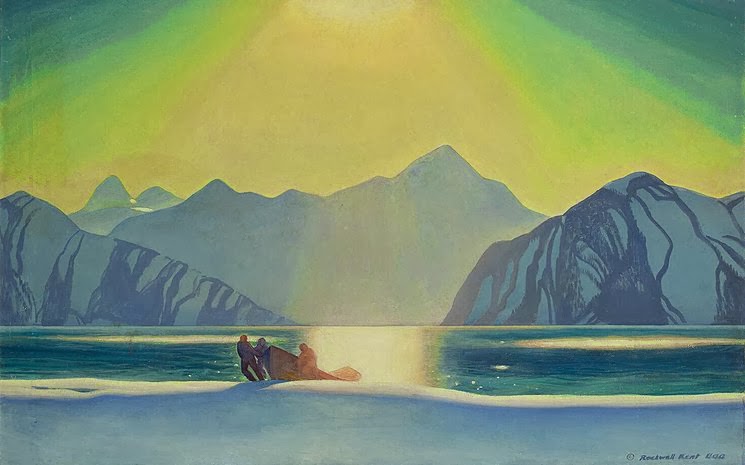Rockwell Kent - Searching for God in Greenland
 |
| "Early November: North Greenland" |
It was the summer of 1929 and a small sailing boat named Direction cruised into Karajak Fiord off the west coast of Greenland. When a sudden williwaw struck, the overmatched vessel foundered leaving its three-man crew shipwrecked. Artist Rockwell Kent packed his rucksack and set off into the wild.
Kent hiked, climbed, scratched and clawed his way across the frozen tundra in a desperate search for help. After a three-day trek, Kent finally stumbled upon a lone kayaker fishing in the ocean. The native Greenlander guided Kent to a nearby village where the kindhearted locals rescued Direction and helped repair the damaged boat.
Rockwell Kent was an experienced adventurer, architect, carpenter, lobsterman, sailor, printmaker, illustrator, writer, dairy farmer and political activist but mostly he was a painter searching for God in the most desolate places on earth.
Rockwell Kent was born in 1882 in Tarrytown, New York and later studied at the New York School of Art under William Merritt Chase and Robert Henri. Kent perfected his craft painting seascapes off the rugged coasts of Maine and Newfoundland. By 1918, he was struggling to develop a personal style and was confused by the stormy art scene battering New York City.
Kent enlisted his nine-year-old son and fled to the wilderness. They reclaimed an abandoned cabin on tiny Fox Island and spent a year in Resurrection Bay, Alaska. On the water and in the shadows of massive, snow-covered peaks, Kent was reborn. It was there that he mastered wood engraving, created original paintings and illustrated a written journal about their quiet adventure.
Kent became an accomplished frontiersman. He once sailed all the way down to Tierra del Fuego and southward from the Strait of Magellan. There he climbed mountains and explored the maze of narrow waterways woven into the tip of South America.
Kent relied on the knowledge and experience gained from these excursions to execute powerful illustrations for a special edition of Moby Dick. The skillful integration of text and images was a tour de force of publishing. The project elevated Herman Melville's story to classic status and earned Kent heaps of deserved, critical acclaim.
During the '30s and '40s, Kent enjoyed celebrity status based on the success of his paintings, illustrations and adventure narratives. If art was Kent's religion, then Greenland was heaven. The icy paradise featured a spectacular landscape inhabited by an extraordinary population of indigenous people. Kent was able to paint, write and illustrate in isolated bliss.
Kent's Greenland paintings are masterpieces of simplicity, structure and light. He depicts the stark beauty of a forbidding landscape, expresses the awesome power of nature and man's fleeting, insignificant place within it. It makes you wonder how people survived in such a harsh environment.
It was the happiest, most productive time of his life and the paintings reflect a certain spiritual fulfillment. His reverence for the extraordinary land becomes obvious. The landscape is reduced to precise architectural forms. Fantastically shaped icebergs trapped in the sea ice are transformed into ghostly cathedrals bathed in an otherworldly light.
The Greenland paintings are not impressionistic attempts to capture fleeting light effects. They're heavy-handed, athletic and hard-edged. They're bold statements made en plein air, expressing the awesome power of Mother Nature and our helplessness when confronted by her. The paintings are not only works of art but also historical documents of a fascinating era in world history. They convey a certain truth not detectable in photographs taken from the same time period.
By the 1950s, Kent's outspoken views on socialism and pacifism got him into trouble. His art was shunned by galleries and museums across America because of his leftist ideology and perceived un-patriotic support for the Russia. Kent was accused of being a communist, denied his U.S. passport and required to testify before the House Committee on Un-American Activities.
In bitter retaliation against a paranoid U.S. Government, Kent gifted 80 paintings and 800 drawings to the Soviet Union. A treasure trove of unique, creative works were removed from American soil forever. Today, a new generation of art lovers, un-phased by political prejudice, have rediscovered the lost landscapes of Rockwell Kent.
 |
| "Brewing Storm. Monhegan" |
 |
| "Sunglare: Alaska" |
 |
| "Admiralty Sound: Tierra del Fuego" |
 |
| "Squall. Greenland" |
 |
| "Cloudy Day. Fjord in Northern Greenland" |
 |
| "Greenland Coast" |
 |
| "Seal Hunter: North Greenland" |
 |
| "Road to Asgaard: Adirondacks" |



Comments
Post a Comment